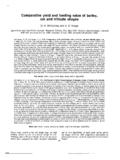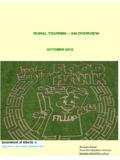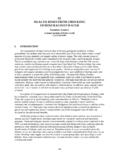Transcription of Monitoring Well Construction, Installation and Development
1 technical Guideline Agdex 096-51 July 2011 IntroductionThis guideline outlines recommended and preferred protocols to construct, install and develop groundwater Monitoring wells at confined feeding operations (CFOs), which are regulated under the Agricultural Operation Practices Act (AOPA). Materials and methods presented are preferred and acceptable for typical situations. Other methods and materials may be acceptable under specific situations, based on the judgment of qualified professionals. Monitoring wells must be constructed, installed and developed by knowledgeable and experienced individuals under the guidance of a suitably qualified professional. Groundwater Monitoring refers to the Monitoring of local groundwater resources to evaluate changes in chemical, biological and physical characteristics. It includes periodic sampling and analysis to detect changes in constituents in groundwater and periodic measurement of water levels to determine the direction of groundwater flow.
2 To be effective, groundwater Monitoring wells should be constructed and installed using methods and materials that minimize the effects on the chemical, biological and physical properties of groundwater samples. Monitoring wells should permit representative groundwater sampling, accurate measurement of groundwater elevation and in-situ hydraulic conductivity and location of Monitoring wellsThe number and location of groundwater Monitoring wells should be determined before decisions are made regarding the materials and methods for constructing and installing the wells. A hydrogeological assessment should be the basis for determining the number and location of Monitoring wells. The NRCB must be contacted in order to receive approval before groundwater Monitoring wells are constructed and installed. The NRCB will evaluate the proposed Monitoring plan and, based on the perceived risk of potential leakage of the facility and the perceived risk to the environment, may require modifications to the plan.
3 If Monitoring wells are installed and constructed without NRCB approval, there is a risk that the well will not be approved and that new or additional wells will be required. Monitoring Well Construction, Installation and DevelopmentPurpose T o guide the construction, Installation and Development of groundwater Monitoring wells Audience Consultants or contractors hired to construct, install, and develop groundwater Monitoring wells at confined feeding operations (CFOs)Relevant Legislation Agricultural Operation Practices Act Risks Addressed Ensure representative groundwater samples Prevent contaminated surface water from reaching groundwater through the well space Prevent groundwater movement and transfer between aquifers Prevent improper construction or Installation of groundwater Monitoring wells.
4 Improperly constructed or installed wells may need to be reclaimed or replaced, resulting in significant additional costsTechnical Guideline Agdex 096-51 July 2011page 2 Drilling and logging boreholesA variety of borehole drilling methods may be appropriate depending on the geology and characterization of each site. The method used should be determined by the qualified professional responsible for installing the Monitoring well(s). Common methods are discussed in Appendix Lithologic logDuring drilling, geologic descriptions should be logged continuously and directly from drilling returns. The lithologic log should be recorded by a qualified individual using either the Canadian System of Soil Classification (NRC, 1988), the Unified Soil Classification System (ASTM, 2006) or the Wentworth scale (1922). There are significant differences in how the three systems describe texture or grain size.
5 The system or combination of systems used must be specified on the drill or borehole logs, and must be used consistently for the site (see Appendix 2).The lithologic log should include a description of soil texture (clay, silt, sand, gravel) or lithology (for example sandstone, siltstone, claystone, coal), grain size, colour, moisture content, consistency, hardness, and secondary features such as staining, mottling, carbonates, gypsum, degree of cementation, degree of weathering and odour. The lithologic description should also include the presence or absence of visible fractures as indicated in core or split-spoon samples, or surface staining on rotary cutting Representative samplesRepresentative samples of sediments encountered during drilling must be collected for at least every metres of drilling, or where changes in lithology are suspected or Decontamination of equipmentDecontamination of drilling and formation sampling equipment is a quality control measure that is included as part of standard drilling procedures.
6 It is important for preventing cross contamination between sampling areas. The professional responsible for the drilling and sampling should evaluate the decontamination requirements for each site. Although decontamination is typically used where contamination is present, it may also be used in uncontaminated areas as a quality control and assurance well construction and installation1. MaterialsMonitoring wells are constructed of environmental quality threaded PVC pipe, 52 millimetre ID Schedule 40, with a machine slotted metres long or to metres long, or slot screen. A metre screen would typically be used for relatively shallow intervals. A to metre screen would typically be used for relatively deeper intervals. Longer screens may be required, depending on the borehole depth and stratigraphy of the site. The length of the screen selected depends on the thickness of the hydrogeologic unit, the vertical scale of the investigation, and specific requirements of the Monitoring program.
7 For typical water table Monitoring wells, a screen metres long is common. The screen must not extend to within less than two metres of the ground surface to allow for an adequate length of bentonite seal above the JointsThe 52 millimetre PVC screens and all plain pipe sections must have threaded flush joints with O rings or Teflon tape at the joints. Solvent welded PVC pipes, screens and couplings should not be used to construct Monitoring wells. PVC glue and primer can potentially introduce organic substances into the monitored environment. Screen bottoms must be closed with a heat welded seal or threaded end cap. 3. Size of boreholesGroundwater Monitoring well components are placed in each borehole. Boreholes must be at least 102 millimetres (approximately four inches) larger than the outside diameter of the casing and screen. For instance, when a 52 millimetre (two inch) well casing is used, the drill borehole diameter should be at least 154 millimetres (approximately six inches).
8 This ensures adequate space around the well screen and casing, which allows for proper placement of completion materials such as filter sand and bentonite, and helps prevent materials from bridging between the casing and borehole walls. 4. Borehole backfillThe annular space between the screened section of the Monitoring well and the borehole wall is backfilled with filter sand, typically 10/20 mesh ( to millimetres) fraction silica sand. Environmental silica sand is used because it does not contribute significant soluble ions to the groundwater. Sand of mixed lithologies may contain minerals that could affect trace element concentrations in monitored groundwater, and is notTechnical Guideline Agdex 096-51 July 2011page 3recommended. The filter sand is placed to approximately metres above the top of the Monitoring well screen to accommodate settling, and to prevent contact between the bentonite seal (described below) and the well screen.
9 As the sand is placed in the borehole, the depth of filter sand pack is sounded with a weighted tape measure to ensure correct placement without bridging. 5. Borehole sealingThe annular space above the sand pack, refered to as the annulus, must be sealed to prevent surface water or shallow groundwater from moving through it. A primary, water tight bentonite seal, approximately metres thick, is placed above the sand pack using bentonite pellets. Bentonite chips are not recommended for the primary seal. If bentonite chips are used for the primary seal, extra care must be taken to ensure that bridging does not occur if water is present in the borehole. To ensure hydraulic isolation between the ground surface and other potential water -bearing horizons, the entire remaining annulus must be backfilled to ground surface with hydrated bentonite chips.
10 Cuttings should never be used to fill the annulus. While bentonite chips are being placed in the annulus, the depth of the bentonite chips must be sounded with a weighted tape measure to ensurecorrect placement of the seal, without bridging in the hole. The bentonite chips must be hydrated, by adding approximatively seven litres of fresh, potable water per 20 kilograms of chips after each bag is type and depth of backfill material should be noted on the well construction top of the Monitoring well must be capped with a snug fitting or threaded PVC cap. A small vent hole or slot should be drilled or cut below the bottom of the cap to allow air movement in and out of the Monitoring well to allow water levels to fluctuate properly. Monitoring well protectionThe Monitoring well must be completed at the surface with a steel protective steel surface casing, which has a lockable cover or some other protective device to prevent damage or tampering.













